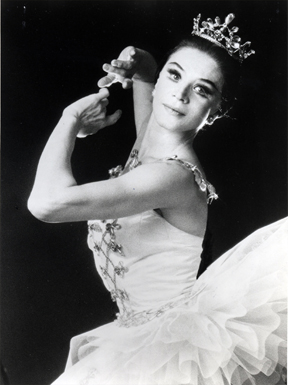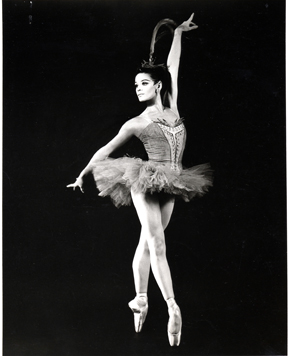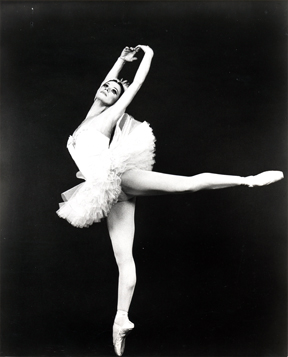“A Tribute to Melissa Hayden”
New York City Ballet Seminar
New York State Theater
New York, NY
December 4, 2006
by Dale Brauner
copyright 2006 by Dale Brauner
 Canadian-born ballerina Melissa Hayden was a member of the New York City Ballet from 1948 until her retirement in 1973. She also danced with Ballet Theatre, Ballet Alicia Alonso and in the corps de ballet at New York’s Radio City Music Hall. Because of her late start (she began dancing at 15), her association with Ballet Theatre and her dramatic style, Hayden was not always considered a “Balanchine ballerina”, yet she created major roles in George Balanchine’s “Divertimento No. 15”, “Agon”, “Stars and Stripes”, Episdoes”, and "Liebeslieder Walzer” (just a sampling of her repertoire). She also taught 23 years at the North Carolina School of the Arts, working a total of about 6,000 students, many of whom went on to dance with New York City Ballet, American Ballet Theatre, San Francisco Ballet and other companies (according to NCSA’s estimation). So she touched a lot of people.
Canadian-born ballerina Melissa Hayden was a member of the New York City Ballet from 1948 until her retirement in 1973. She also danced with Ballet Theatre, Ballet Alicia Alonso and in the corps de ballet at New York’s Radio City Music Hall. Because of her late start (she began dancing at 15), her association with Ballet Theatre and her dramatic style, Hayden was not always considered a “Balanchine ballerina”, yet she created major roles in George Balanchine’s “Divertimento No. 15”, “Agon”, “Stars and Stripes”, Episdoes”, and "Liebeslieder Walzer” (just a sampling of her repertoire). She also taught 23 years at the North Carolina School of the Arts, working a total of about 6,000 students, many of whom went on to dance with New York City Ballet, American Ballet Theatre, San Francisco Ballet and other companies (according to NCSA’s estimation). So she touched a lot of people.
On a chilly Monday, some of those who worked with her, danced with her, studied with her, loved her as her children and grandchildren, and watched her dance came to pay tribute to Melissa Hayden, who died in August, at age 83, from pancreatic cancer.
Hayden’s long-time partner, Jacques d’Amboise, moderated the New York City Ballet seminar, with company-mate Suki Schorer and former students, ABT principal Gillian Murphy and NYCB corps de ballet member Megan LeCrone on hand. D’Amboise was typically warm and entertaining. Clips were shown of Hayden in “Tchaikovsky Pas de Deux”, a pas from “The Nutcracker”, and a snip from “The Still Point”, memories shared and even a “Millie Step” created.
Meeting Melissa Hayden
Suki Schorer: The first time I saw her, she was dancing “Stars and Stripes” with you (D’Amboise). Her wit…the two of you together...you both made me laugh and scream. That season when I was just here in New York, just looking because I was still a member of San Francisco Ballet, I saw her do “Swan Lake.” She could make me cry -- her port de bras was so beautiful. Those long incredible arms. In “The Cage” she was just not human. Later, when she did the first movement of “Brahms-Schoenberg Quartet” that Balanchine choreographed for her, she swooped and swooned…she was so beautiful. Every performance with her was so unique. She gave her all. When she gave class she gave her all and she expected the same from you. That made it hard to be her student.
Melissa Hayden, the teacher
 Gillian Murphy: I went to North Carolina School of the Arts when I was 14. I remember my first class with her I heard how tough she could be and to be prepared. So I went in there with a sense of humor and to be prepared to work very hard and not to take anything personally. We just connected right away. She was such an inspiration in class and coaching me in all the different ballets. We grew to be great friends, as well. That was just so exciting to see.
Gillian Murphy: I went to North Carolina School of the Arts when I was 14. I remember my first class with her I heard how tough she could be and to be prepared. So I went in there with a sense of humor and to be prepared to work very hard and not to take anything personally. We just connected right away. She was such an inspiration in class and coaching me in all the different ballets. We grew to be great friends, as well. That was just so exciting to see.
Her classes were hard but so wonderful. I think more than even the technique that she focused on so much – moving dynamically and offering insight into the technical aspect – she focused so much on the intention and the purpose. She led so much by example with her energy and her devotion to the art form – that was the greatest thing she taught all her students.
Megan LeCrone: I also began at North Carolina School of the Arts when I was 14. I came in the middle of my freshman year of high school. She was my first teacher there. My first ballet class there was with her. I also had heard how tough the class was but I had a different attitude than Gillian. I was terrified. We connected mostly in rehearsal. We worked on “Allegro Brillante”, “The Four Temperaments” and then the “Agon” pas de deux. That was where I learned the most from her, in rehearsing the different ballets.
Melissa Hayden, the mentor
Jacques d’Amboise: Once there was a new girl to the New York City Ballet, an apprentice. Millie had her favorite place at the barre. We all did. Millie came in late and this new girl was in her place. Uh, oh. “Who are you?” (Imitating Hayden’s distinctive nasal voice) “Marjorie” (meekly) “Well Maggie. You’re in my place. But it’s OK, just move a little bit down…so I won’t kick you.” And then Melissa adopts her. “Let me fix your hair.” She watched Marjorie in the corps, helped her with her costume. I don’t know what (Hayden) weighed…112 pounds? But there was 10,000 pounds of generosity in that ribcage.
Gillian Murphy: She helped with hair and makeup. But what I remember was in my second year of high school she started making lunch for me too. I guess I was a picky eater and I was pretty skinny at that point, at 14 or 15 year old. So she was worried about me. I was perfectly fine but she started making these sandwiches and putting little cookies in there. She made me lunch on a regular basis in these little plastic bags. It was amazing. It was sweet. It also was the first time I went to her house to compare the intensity she had in the studio and then she turned into the ultimate hostess, cooking and telling stories and making everybody laugh.
Melissa Hayden, the professional
 Jacques d’Amboise: In addition to all the things dancers do, she used to travel with weights — therapeutic weights — so she could build up strength. She carried a full-length mirror so she could put it up in her hotel room so she could look at her line while she practiced. She practiced all the time. It was a nightmare to rehears with her. She kept jugs of Gatorade in all the wings; thermoses of hot tea with lemon and honey. And an oxygen tank in each wing so she could take quick whiffs when she entered and exited, just so she could always do her best. She had hundreds of toe shoes in the wings. She could take a toe shoe off and put another one on in about three seconds. She felt the type of the shoe and the quality of the stage floor had a relationship and the kind of steps she had to dance needed certain types of shoes. There were shoes better to balance in and shoes better to turn in and shoes better to jump in. She carried bags and bags of vitamins. In the morning, she laid out 40 or 50 of them on the table like a mosaic alongside her eggs and bacon. She also had a massage before the performance. And if she didn’t feel at her peak she would try to pick a fight. “That costume looked lousy on you. Why don’t you change it?” The music was playing, so I said “What the hell are you talking about?” The reason she tried to pick a fight was that for some reason she didn’t feel the adrenaline going. She needed that extra fight. When I saw her coming I’d do the sign to ward of vampires. She’d then go find a stagehand to pick a fight with. And the music is going on. “You’re in my way.” (to the stagehand) “Huh?” “You know I’m about to make an entrance? You know, I’m the Swan Queen. You’re never going to see anything better.” “Listen lady…” “Just move out of my way.” And then she was on stage, dancing beautifully. And the stagehand is walking around backstage going “What a bitch. What a bitch.” And during the bows she’s going “Where’s the stagehand? I love him. He helped me get through it.” All the stage crew loved Melissa. She was something else.
Jacques d’Amboise: In addition to all the things dancers do, she used to travel with weights — therapeutic weights — so she could build up strength. She carried a full-length mirror so she could put it up in her hotel room so she could look at her line while she practiced. She practiced all the time. It was a nightmare to rehears with her. She kept jugs of Gatorade in all the wings; thermoses of hot tea with lemon and honey. And an oxygen tank in each wing so she could take quick whiffs when she entered and exited, just so she could always do her best. She had hundreds of toe shoes in the wings. She could take a toe shoe off and put another one on in about three seconds. She felt the type of the shoe and the quality of the stage floor had a relationship and the kind of steps she had to dance needed certain types of shoes. There were shoes better to balance in and shoes better to turn in and shoes better to jump in. She carried bags and bags of vitamins. In the morning, she laid out 40 or 50 of them on the table like a mosaic alongside her eggs and bacon. She also had a massage before the performance. And if she didn’t feel at her peak she would try to pick a fight. “That costume looked lousy on you. Why don’t you change it?” The music was playing, so I said “What the hell are you talking about?” The reason she tried to pick a fight was that for some reason she didn’t feel the adrenaline going. She needed that extra fight. When I saw her coming I’d do the sign to ward of vampires. She’d then go find a stagehand to pick a fight with. And the music is going on. “You’re in my way.” (to the stagehand) “Huh?” “You know I’m about to make an entrance? You know, I’m the Swan Queen. You’re never going to see anything better.” “Listen lady…” “Just move out of my way.” And then she was on stage, dancing beautifully. And the stagehand is walking around backstage going “What a bitch. What a bitch.” And during the bows she’s going “Where’s the stagehand? I love him. He helped me get through it.” All the stage crew loved Melissa. She was something else.
Melissa Hayden, death
 Jacques d’Amboise: I was walking down Columbus Avenue and somebody called out “Hey Jacques d’Amboise. Did you hear Melissa Hayden is dying?” Melissa wasn’t going to go easy. She didn’t live her life easy and she wasn’t going to die easy. She was going to die dramatically. (getting emotional) So I got on a plane and went down to see Melissa. I got to Wake Forest Hospital. And there’s Melissa. She had dyed her hair black and it looked like wet seaweed. She looked so tiny and frail. And she’s got the oxygen mask. And she goes (heavy breathing), “You came for my last dance?” Isn’t that wonderful? And I know Melissa, you are here as a ghost, I think the best moment of my life was that moment with you. She calls out to her husband, “Don. If he stays overnight there’s a pot roast in the freezer.” We sit and talk for a few minutes. I had to leave and I go to say goodbye. “Goodbye Melissa. I came down here to tell you how great you are.” “Bah! I love you too. All this talk about the afterlife; there is an afterlife and it’s what’s left after you acted in your life. We did a good job.”
Jacques d’Amboise: I was walking down Columbus Avenue and somebody called out “Hey Jacques d’Amboise. Did you hear Melissa Hayden is dying?” Melissa wasn’t going to go easy. She didn’t live her life easy and she wasn’t going to die easy. She was going to die dramatically. (getting emotional) So I got on a plane and went down to see Melissa. I got to Wake Forest Hospital. And there’s Melissa. She had dyed her hair black and it looked like wet seaweed. She looked so tiny and frail. And she’s got the oxygen mask. And she goes (heavy breathing), “You came for my last dance?” Isn’t that wonderful? And I know Melissa, you are here as a ghost, I think the best moment of my life was that moment with you. She calls out to her husband, “Don. If he stays overnight there’s a pot roast in the freezer.” We sit and talk for a few minutes. I had to leave and I go to say goodbye. “Goodbye Melissa. I came down here to tell you how great you are.” “Bah! I love you too. All this talk about the afterlife; there is an afterlife and it’s what’s left after you acted in your life. We did a good job.”
Photos:
Top:
Melissa Hayden in "Cortege Hongroise."
Second: Melissa Hayden in "The Firebird."
Third:
Melissa Hayden in a studio shot by Maurice Seymour.
Fourth: Melissa Hayden in "Swan Lake."
Volume 4, No. 44
December 11, 2006
copyright ©2006 by Dale Brauner
www.danceviewtimes.com